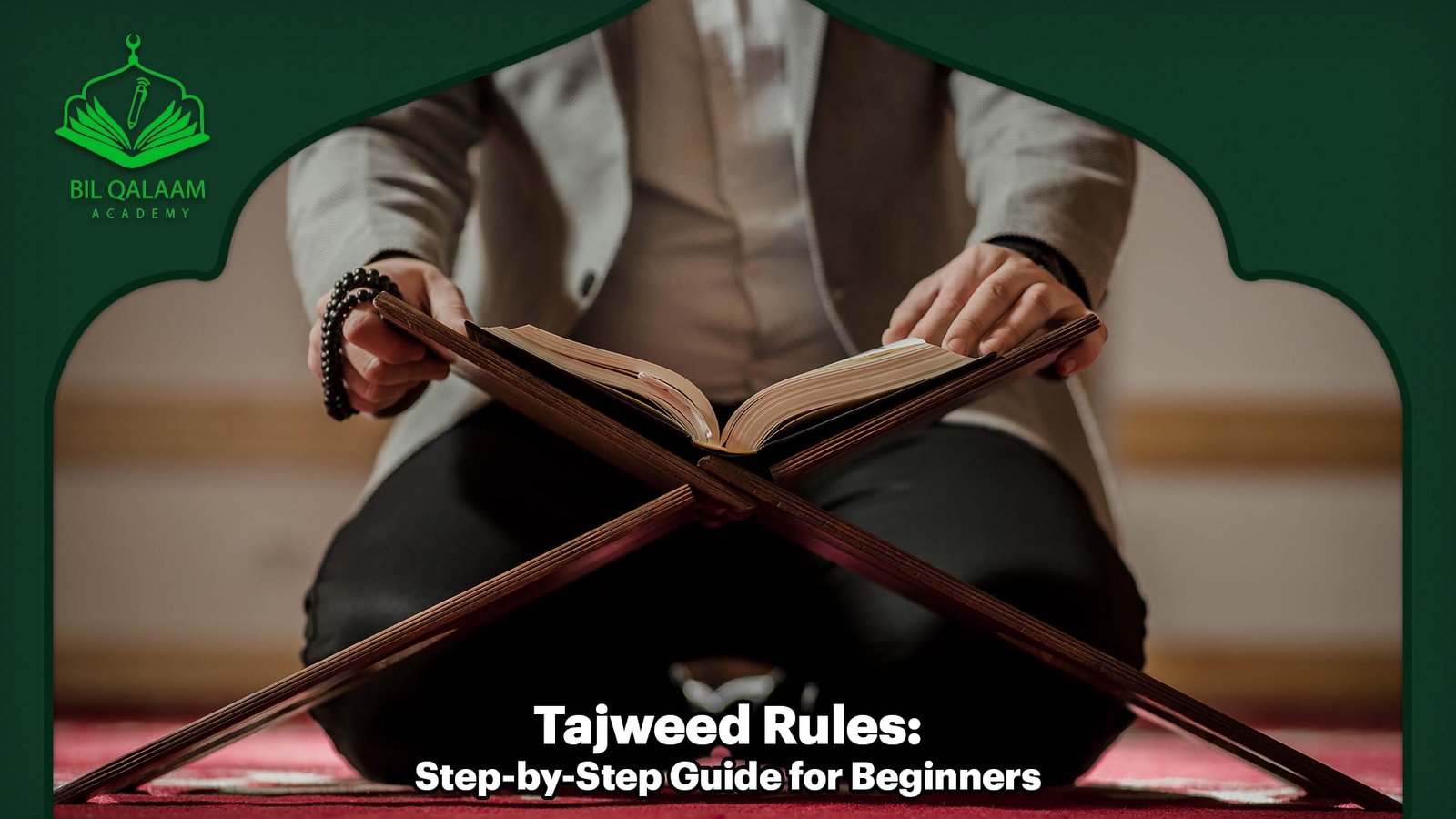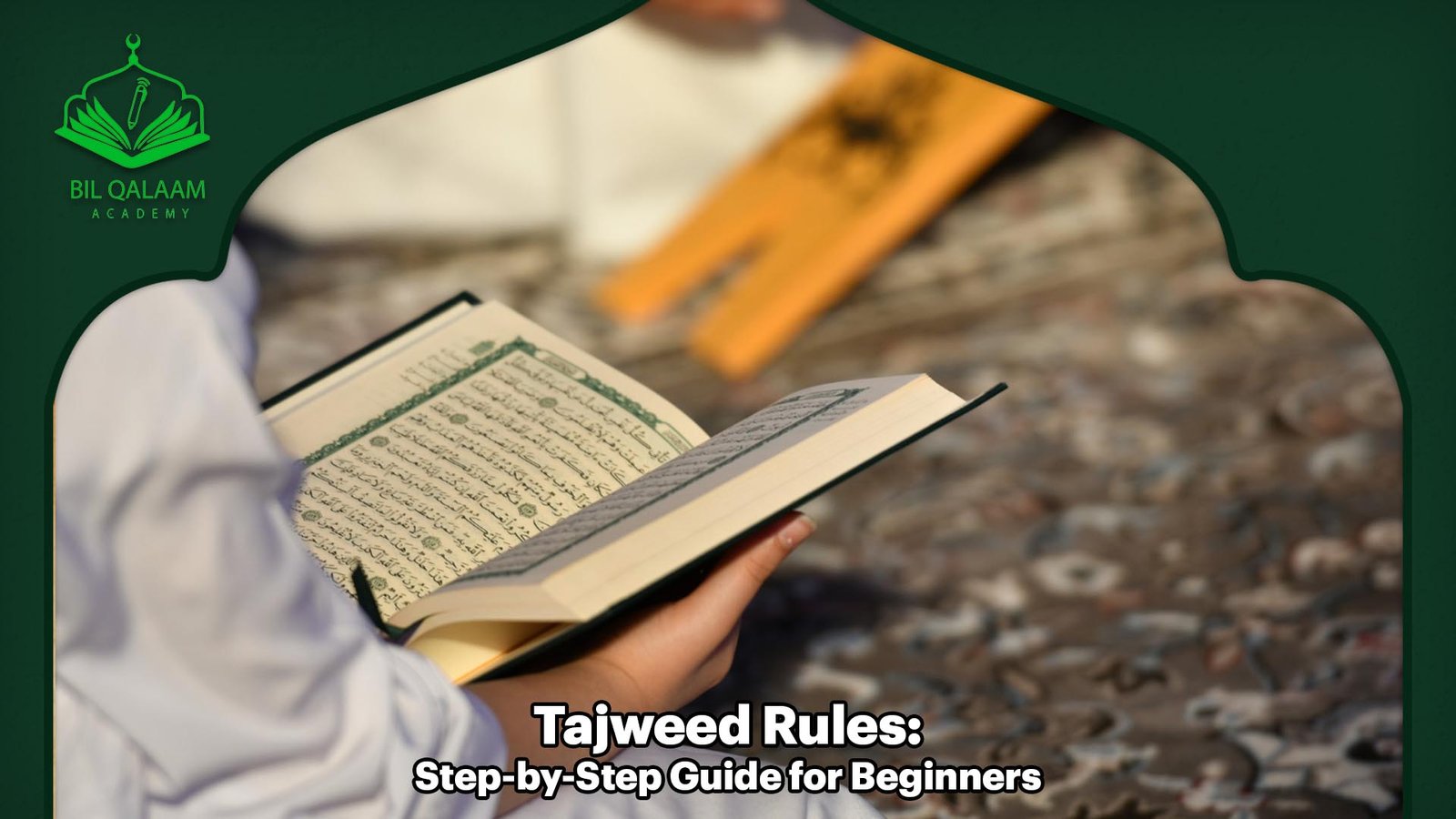Tajweed rules are guidelines for precise Quran recitation, covering pronunciation, pauses, and elongations to ensure accuracy, beauty, and proper conveyance of meaning.
Key aspects include Makharij (articulation points), Sifat (characteristics of letters), Waqf (pauses), Ibtida (starting), Madd (elongation), Ghunnah (nasal sounds), and rules for Noon Sakinah and Tanween.
Learning to read the Qur’an correctly is a spiritual journey that opens the heart to the beauty and depth of Allah’s message.
One of the key elements of this journey is understanding and applying Tajweed rules.
For beginners, mastering the Tajweed rules may seem daunting at first.
But with the right guidance and mindset, anyone can perfect recitation Quran.
This guide will help you explore the meaning of Tajweed rules, their importance, and how to learn Tajweed online.
With the help of the Blqlm Academy, known for its expertise in teaching Tajweed rules simply and effectively.
Meaning of Tajweed
The word Tajweed (تَجْوِيد) comes from the Arabic root “jawwada,” which means to make better or improve.
In the context of the Qur’an, Tajweed refers to the set of rules governing the correct pronunciation and articulation of letters during Qur’anic recitation.
Tajweed rules ensure that each letter is given its due right, its makhraj (place of articulation) and Sifat (characteristics).
So that the recitation reflects the way the Prophet Muhammad ﷺ recited the Qur’an.
For a beginner, understanding Tajweed rules begins with learning the basics.
How Arabic letters are pronounced, how long vowels and short vowels work.
And how specific letters interact in the context of the verses.
Concepts such as noon saakinah, tanween, and izhaar are among the foundational rules that students gradually grasp as they deepen their learning.

Importance of Tajweed Rules
The importance of Tajweed rules cannot be overstated, particularly in light of the Qur’an’s sacred nature.
The Qur’an is not just read; it is recited as an act of worship.
Reciting the Qur’an without adhering to Tajweed rules may result in mispronunciations that alter the intended meaning of the words.
Something that every Muslim must strive to do is to read and recite the Qur’an correctly.
Allah revealed the Qur’an to be recited with clarity and beauty.
In Surah Al-Muzzammil, verse 4, Allah commands: “And recite the Qur’an with measured recitation (Tarteel).”
This is a direct reference to the rules of Tajweed.
When a person applies Tajweed rules during recitation, it reflects a respect for the sacred text.
Enhances the spiritual experience and fulfills the duty of preserving the divine message in its authentic form.
Additionally, proper recitation brings tranquility to the soul.
The rhythmic and melodic nature of the Qur’an, when recited with correct Tajweed rules, touches the hearts of both the reader and listener.
It’s not just a technical skill but a spiritual practice that brings one closer to Allah.
Benefits of Tajweed Rules
Learning and applying Tajweed rules offers numerous benefits, both worldly and spiritual.
First, it helps learners avoid mistakes that can alter the meanings of Qur’anic verses.
For instance, the incorrect pronunciation of a single letter could result in a completely different word with a different meaning.
Second, learning Tajweed rules strengthens one’s connection with the Qur’an.
Reciting the Quran with Tajweed makes the reading process smoother, more fluent, and more enjoyable.
It enhances comprehension and Quran memorization, especially when learners understand how sound and pauses impact the overall rhythm of the Quran recitation.
Third, the Tajweed rules are a means of gaining immense reward from Allah.
The Prophet Muhammad ﷺ said: “The best among you is those who learn the Qur’an and teach it.”
By striving to improve your Quran reading with Tajweed, you are actively engaging in an act that the Prophet highly praised.
Finally, mastering Tajweed rules increases confidence in public recitation Qur’an, whether during Salah (prayer), Taraweeh, or community gatherings.
It allows you to recite the Qur’an correctly without hesitation, embarrassment, or fear of error.

Learn Quran with Tajweed Online.
Learning the Quran with Tajweed is easier than ever before.
Blqlm Academy, a leading platform in online Quranic education, provides structured and interactive courses designed specifically for beginners.
Their expert instructors guide students through the basic Tajweed rules.
To ensure that learners understand and apply each concept correctly before moving on to more advanced topics.
Online Tajweed classes offer flexibility for learners of all ages, from kids to adults.
Whether you’re a busy parent, a student, or a professional.
Most online courses begin with foundational lessons in Arabic letters and Noorani Qaida, a stepping stone for mastering Tajweed.
Students at Blqlm Academy progress to more complex rules like noon saakinah, tanween, izhaar, idghaam, and others.
These courses typically include video tutorials, live sessions, recorded lectures, and interactive quizzes that reinforce learning and track progress.
One major benefit of learning Tajweed online is the one-on-one attention students receive.
Personalized feedback allows learners to correct mistakes in real-time and build confidence in their Quran recitation.
Top Online Tajweed Rules Course
To select the best course to learn Tajweed rules, Blqlm Academy stands out as a top-tier platform trusted by thousands of learners around the world.
Their Tajweed for Beginners course is specifically designed to guide new learners through a structured curriculum that covers all the essential rules of Tajweed.
This course typically begins with a basic understanding of Arabic phonetics.
Followed by detailed explanations of the rules of noon saakinah, tanween, izhaar, ikhfaa, qalqalah, and ghunnah.
These topics are taught through easy-to-follow video lessons and practical Quran recitation exercises.
That helps learners implement what they’ve studied.
Instructors at Blqlm Academy are certified Qur’an teachers with years of experience in teaching Tajweed both online and in traditional settings.
Their approach is gentle, encouraging, and tailored to each learner’s pace.
Moreover, the platform provides certificates upon completion.
This adds a sense of accomplishment and motivation for students to continue their Qur’an journey.
Interactive tools like Tajweed charts, audio clips for practice, and guided Quran reading plans make the learning process enjoyable and effective.
Whether you are starting from scratch or want to brush up on your existing knowledge, Blqlm Academy’s Tajweed course is a solid choice.

Different Tajweed rules:
- Makharij al-Huroof (Articulation Points): This rule dictates where each Arabic letter is pronounced in the mouth and throat.
Mastering these points is fundamental to accurate pronunciation.
- Sifat al-Huroof (Characteristics of Letters): This rule describes the specific characteristics of each letter.
Such as whether it is heavy (tafkhim) or light (tarqiq), which affects how it is pronounced.
- Waqf and Ibtida (Stopping and Starting): These rules govern where to pause and resume recitation to maintain the meaning of the verses.
There are specific guidelines for permissible and prohibited stops.
- Madd (Elongation/Lengthening): Tajweed dictates how long certain vowels are stretched, with varying lengths depending on the context.
Madd can be due to a hamza (ء) or Sukoon following a long vowel.
- Ghunnah (Nasal Sound): Ghunnah is a nasal resonance applied to certain letters, especially when followed by specific letters like Meem (م) or Noon (ن) with a shaddah, and during the Tajweed of Noon Sakinah and Tanween.
- Noon Sakinah and Tanween: The Tajweed rules address how the letters Noon (ن) with a Sukoon (a sign indicating no vowel) and Tanween (a nunation sound at the end of a word) are pronounced when followed by other letters.
There are four main rules for Noon Sakinah and Tanween: Izhaar (clear pronunciation), Idgham (merging), Iqlab (conversion), and Ikhfa (partial concealment).
- Qalqalah (Echoing Sound): Qalqalah involves adding a “bounce” or echoing sound when pronouncing certain letters (Qaf, Taa, Baa, Jeem, Daal) when they have a Sukoon.
- Idgham (Merging): Idgham involves merging a non-voweled letter with the following letter, creating a blended sound.
- Iqlab (Conversion): Iqlab is the transformation of Noon Sakinah or Tanween into a Meem (م) before the letter Baa (ب).
- Ikhfa (Concealment): Ikhfa involves concealing the sound of Noon Sakinah or Tanween when followed by specific letters.
- Heavy and Light Letters (Tafkhim & Tarqiq): Some Arabic letters are pronounced with a heavier or lighter sound based on their characteristics and the surrounding letters.
- Laam Shamsyiah and Qamaryiah (The solar and lunar lam): These rules govern the pronunciation of the “Laam” (ل) when it appears with the definite article “Al” (ال).
These rules, when applied correctly, enhance the beauty and clarity of Quranic recitation, allowing for a deeper understanding of the sacred text.
Tajweed Rules in English
Tajweed rules are a set of guidelines for reciting the Quran with proper pronunciation and articulation.
These rules govern how each letter is pronounced, including its characteristics, place of articulation, and how it interacts with other letters.
Mastering Tajweed aims to beautify the Quran recitation and ensure the preservation of the Quran’s original form.
The rules of Tajweed consist of pronunciation guidelines that ensure each Quranic letter is recited correctly.
The basic Tajweed rules include articulation points (makharij), characteristics of letters (sifaat), rules of noon, Tanween and Meem, elongation (Madd), and stopping rules (waqf).

